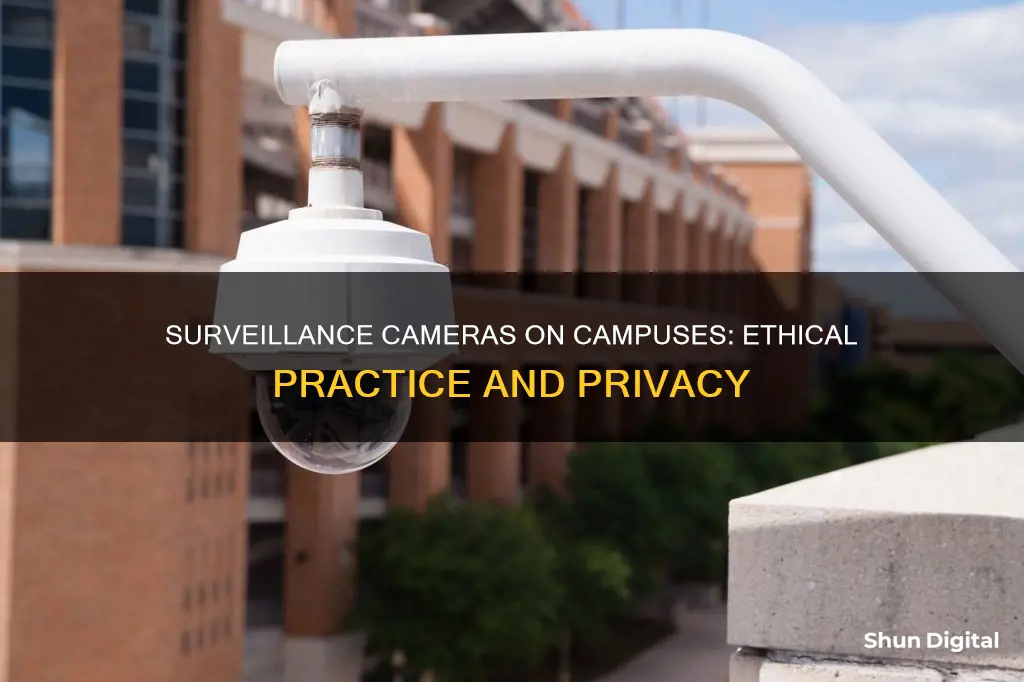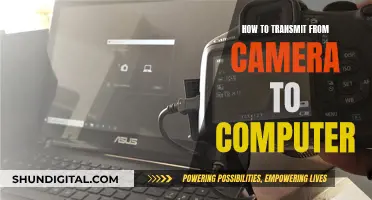
Public surveillance cameras on campuses have become increasingly prevalent, with over 80% of public schools in the US employing them. While they are generally legal, there are several ethical and privacy considerations to take into account when installing them. This includes respecting reasonable expectations of privacy, such as in restrooms, locker rooms, and staff offices, and obtaining consent from students, teachers, and parents. Additionally, the placement of cameras, integration with other security systems, and data storage and release are important factors to consider when implementing public surveillance cameras on campuses.
| Characteristics | Values |
|---|---|
| Camera selection | Megapixel, panoramic, hemispheric, pan/tilt/zoom (PTZ), analog high-resolution, ultra wide dynamic range, infrared |
| Camera placement | University labs, research facilities, power stations, water treatment facilities, parking garages, dorm entrances, large public areas, arenas, entrances to locker rooms, stairwells, elevators, hallways, classrooms, cafeterias, playgrounds, athletic fields, building entrances and exits, administrative offices, near storage areas, etc. |
| Camera visibility | Visible cameras are recommended as some states have stricter laws around hidden surveillance cameras. |
| Signage | Signage is generally unnecessary but may be included to deter bad behavior. |
| Data preservation | Procedures should be in place to preserve data related to any incident. |
| Data storage | The policy should help devise procedures to keep the recorded material safe. |
| Data release | Information should only be released to people recognized by the school policy, without breaching any individual's privacy. |
| Data access | Access should be controlled and limited to authorized personnel only. |
| Surveillance use | Surveillance cameras must be used to avoid unnecessary intrusions, without intervention in academic freedom, privacy, and freedom of speech. |
| Surveillance avoidance | Surveillance is not permitted in areas where privacy is expected, including restrooms, locker rooms, changing rooms, and staff offices. |
What You'll Learn
- Camera placement: in public areas only, such as entrances, cafeterias, and parking lots
- Privacy: avoid private spaces like restrooms, dorms, and staff offices
- Data storage: keep recorded material safe and only disclose when necessary
- Signage: make people aware they are being recorded
- Integration: ensure the system integrates with other security measures

Camera placement: in public areas only, such as entrances, cafeterias, and parking lots
When placing surveillance cameras in public areas on campuses, it's crucial to focus on specific locations that will maximise the benefits of enhanced security and deterrence of criminal activities without infringing on individuals' reasonable expectations of privacy. Here are some instructive guidelines for camera placement in public areas such as entrances, cafeterias, and parking lots:
Entrances
Entrances, including campus entrances/exits, dormitory entrances, and entryways to locker rooms, are ideal locations for surveillance cameras. These areas benefit from the watchful eye of video surveillance, deterring unauthorised access and monitoring suspicious activities. Dome cameras are recommended for main entrances and exits due to their wide coverage and discreet design, capturing a broad view while blending with architectural aesthetics.
Cafeterias
Cafeterias and dining halls are high-traffic areas where petty theft and bullying may occur. Surveillance cameras assist in deterring and identifying such incidents, contributing to a safer dining experience. A mix of camera types, such as panoramic or 360-angle cameras, can be used based on the specific layout and needs of these areas. It is important to ensure that cameras are placed discreetly to maintain a non-intrusive dining environment while still providing effective surveillance.
Parking Lots
Parking lots are often targeted for theft and vandalism, especially in poorly lit sections. Bullet cameras are well-suited for these open spaces, offering long-range viewing capabilities and the ability to identify potential security threats. Surveillance in these areas acts as a deterrent and provides crucial footage for investigations, enhancing vehicle and pedestrian safety. Additionally, features like facial recognition or license plate recognition can further enhance security measures during student pickup.
General Considerations
When placing cameras in public areas, it is essential to respect individuals' reasonable expectations of privacy. This means avoiding areas such as restrooms, locker rooms, and occupied student residential rooms, where privacy is expected. The placement of cameras in plain sight is generally recommended, and some states have stricter laws regarding hidden surveillance cameras. It is also important to ensure that the use of cameras is in line with state-specific regulations and that the privacy rights of students, faculty, and staff are respected.
Understanding Camera Raw's Profile Tab
You may want to see also

Privacy: avoid private spaces like restrooms, dorms, and staff offices
When installing security cameras on campuses, it is crucial to respect individuals' "reasonable expectations of privacy". Video surveillance is illegal in locations where privacy is expected, such as restrooms, locker rooms, and changing areas. Therefore, when implementing security cameras on campus, it is essential to avoid placing cameras in these private spaces.
Restrooms, both public and staff restrooms, fall under areas with a reasonable expectation of privacy. Video surveillance in these areas is illegal and would violate privacy rights. Similarly, staff offices, where employees have a reasonable expectation of privacy, should also be off-limits for security cameras. This includes personal offices and spaces that only staff have access to.
Dormitories or student residences are another type of private space that should be avoided when installing security cameras. While the specific laws regarding video surveillance in dorms may vary across different states, it is generally understood that students have a reasonable expectation of privacy in their living quarters. Therefore, placing security cameras inside dorm rooms would be an invasion of privacy.
Additionally, when considering the placement of security cameras, it is important to be mindful of areas adjacent to or directly outside restrooms, dorms, and staff offices. While these areas may be considered public spaces, the line of sight of the cameras should not intrude on the privacy of the aforementioned private spaces. This could include avoiding direct lines of sight into windows or positioning cameras to avoid capturing audio from private conversations in these areas.
By respecting the privacy of individuals on campus, the security measures can focus on public spaces and common areas, such as hallways, cafeterias, gyms, and auditoriums, where they can effectively improve safety and visibility without infringing on personal privacy.
Polaroid 600 Camera: How Long Do Batteries Last?
You may want to see also

Data storage: keep recorded material safe and only disclose when necessary
When installing surveillance cameras on campuses, it is important to consider the safe storage of recorded material. This ensures that the data is only disclosed when necessary and can be used as evidence in the event of an incident. Here are some guidelines for data storage when using surveillance cameras:
Local Storage
Local storage refers to storing video recordings on-site, either within the camera itself or through a centralised system like a Network Video Recorder (NVR) or Digital Video Recorder (DVR). While local storage offers some ease of use and connectivity benefits, it also has drawbacks. For example, accessing footage can be more difficult, and there is a risk of data loss if the device fails or is damaged. Additionally, local storage may have limited capacity and can be vulnerable to technical issues and physical tampering.
Cloud Storage
Cloud storage has become an increasingly popular alternative to local storage. It offers benefits such as cost-effectiveness, improved security, scalability, and disaster recovery. Cloud storage also removes the risk of physical tampering and data loss due to device failure. However, one challenge with cloud storage is transmitting large video files, especially in locations with limited bandwidth or unreliable connectivity.
Hybrid Cloud Solutions
To maximise the benefits and minimise the drawbacks of both local and cloud storage, many organisations are now opting for hybrid cloud solutions. This approach combines local and cloud storage, allowing for greater flexibility and reliability. With hybrid cloud storage, organisations can take advantage of the accessibility and security of the cloud while also having a local backup to address connectivity issues.
Secure Data Storage
Regardless of the storage method chosen, ensuring the security and integrity of the data is crucial. This includes protecting the data from unauthorised access, tampering, or destruction. Additionally, having a backup power supply is essential to ensure the cameras can continue operating during power outages.
Compliance and Privacy
It is important to comply with any legal and privacy requirements when storing surveillance data. This may include obtaining consent, respecting individuals' reasonable expectations of privacy, and adhering to specific state or industry regulations regarding data retention and privacy.
By following these guidelines, campuses can ensure that their surveillance camera data is securely stored and only disclosed when necessary, protecting the privacy of individuals while also providing valuable evidence in the event of an incident.
The Evolution of Movie Cameras: A Historical Perspective
You may want to see also

Signage: make people aware they are being recorded
While not always legally required, signage is an important way to make people aware they are being recorded by surveillance cameras. This is especially important in areas where people have an expectation of privacy, such as locker rooms and restrooms, where recording is illegal.
In the context of public surveillance cameras on campuses, it is generally recommended to install cameras in locations where they are plainly visible. This is because some states, such as New Hampshire, Maine, Kansas, South Dakota, and Delaware, require consent for hidden cameras of any kind.
Even if not legally required, posting signs indicating the presence of a camera is a good idea, according to experts. This can deter crime and make it less likely that individuals will engage in criminal behavior.
In the case of North Harris Montgomery Community College District in Texas, they have made their video surveillance efforts obvious by making cameras and signs visible in public areas such as parking lots, some hallways, and money exchange areas. This approach not only deters crime but also makes people feel safer on campus.
When placing signage, it is important to consider the specific laws of your state regarding video surveillance. While there is no specific federal law governing the use of security cameras, there are national consent and privacy laws that apply, and many states have their own regulations. For example, in Delaware and Connecticut, businesses must notify employees and customers if there are any video cameras on the property that may violate expectations of privacy, such as in bathrooms or changing rooms.
To ensure compliance with privacy laws, it is generally recommended to avoid placing cameras in areas where individuals have a reasonable expectation of privacy. This includes places such as restrooms, locker rooms, and employee break rooms (in some states).
By making people aware of the presence of cameras through signage and strategic placement, you can help to deter criminal activity and ensure that individuals' privacy rights are respected.
Understanding Camera Raw's Haze Removal Tool
You may want to see also

Integration: ensure the system integrates with other security measures
Surveillance cameras are just one part of a comprehensive security strategy. To ensure the safety of students, faculty, and staff, institutions should integrate their camera systems with other security measures.
One important integration is with access control systems. For example, if a student is caught on camera lending their access card to a stranger, the access control system can be used to prevent that individual from entering campus buildings in the future.
Surveillance cameras can also be integrated with emergency response protocols. For instance, if a suspicious package is left in a campus building, security cameras can provide valuable footage to help identify the perpetrator. This information can then be used to trigger an emergency response and notify students and staff of a campus-wide lockdown.
In addition, universities are increasingly integrating video surveillance with other applications on an IP network, such as building access controls and campus cards. This allows for remote monitoring of buildings and can trigger an alarm if a student enters a residence hall after hours, capturing live video of the person for a real-time view.
Furthermore, some universities are using video analytics to enhance their security systems. Video analytics can be programmed to detect suspicious patterns of behaviour and trigger alarms based on object size, loitering, or the removal of objects from a scene.
By integrating surveillance cameras with other security measures, universities can create a seamless security operation that enhances the safety and well-being of the campus community.
Camera Tickets: Legal in Tennessee?
You may want to see also
Frequently asked questions
Security cameras can be placed at main entrances, campus exits, near storage areas and lockers, parking lots, conference rooms, playgrounds, classrooms, hallways, recreational facilities, and cafeterias.
Security cameras are not permitted in areas where there is a reasonable expectation of privacy, such as restrooms, private dorms, changing rooms, lockers, and staff offices.
Security cameras can help detect and prevent student vaping and smoking, improve teacher instruction, and protect students and teachers by providing clear evidence of incidents, thereby reducing the risk of bullying, abuse, or other harmful behaviours.







